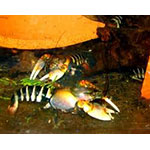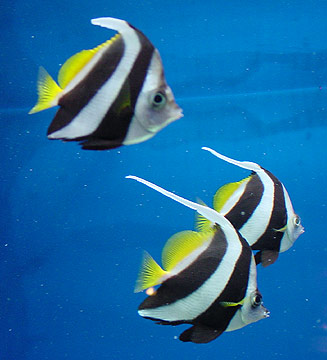Yellow Tiger Goldfish

|
Scientific Name: Carassius auratus Price: Upon Request Origin: Indonesia, Papua New Guinea Family: Parastacidae NOT AVAILABLE NOW |
|
Other Names: Yello Tiger Crayfish, Cherax peknyi, Cherax sp. zebra, Cherax sp. tiger, Cherax cf. papuanus, Tiger Crayfish, Zebra Crayfish |
|
Technical Info
Temperature: 20 - 26 ℃
pH: 7.2 - 7.8
GH: 5 - 20
Max size: 15 cm
Min Tank size: 100 Ltr
Position in Aqua: Bottom swimmer
Description
Yellow Tiger Goldfish is a small lobsterlike freshwater crustaceans with a thin, but tough exoskeleton that it shed during development. There are some different color variations existing, but most zebra crayfish have a dark brown color, with a yellowish to orange coloring on their carapace and claws. Some of them have white and bluish claws. They have wide, white stripes on their tails.
Food
Omnivorous; unfussy eater, it will readily accept any live and dried food (tubifex, snails, bloodworms, fish and green vegetables). Crayfish may eat aquatic plants, or damage them when digging.
Breeding
In aquariums, spawning is possible any time of year. The male makes a little sperm packet and places it on the female's stomach. The female then spawns her eggs, passing them through the sperm packet so that the eggs get fertilized. It is not uncommon for the female to lose a claw during this process. She then places the eggs under her tail where they will be kept until they are ready to be released. How long this will be depends on the water temperature and the species, but it will be at least 4 weeks. A lot of other factors can also affect the length of the egg carrying period, such as water quality, and food supply and quality. The mother will watch over the young for a short time after birth.
Compatible with
These Crayfish can be furiously territorial and aggressive to other Crayfish and any other inhabitants that don't get out of their way. A large tank is thus required and only compatible with species that will give it a wide berth. This species should not be kept with long finned fish or slow fish because those fish are easy targets for the crayfish. Do not mix with other species of crayfish. In addition multiple crayfish should only be kept together if they are roughly the same size otherwise the larger and more powerful crayfish will eat the smaller one.

